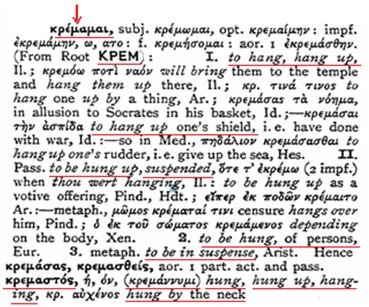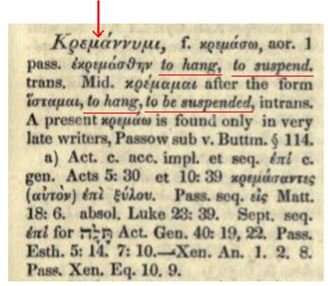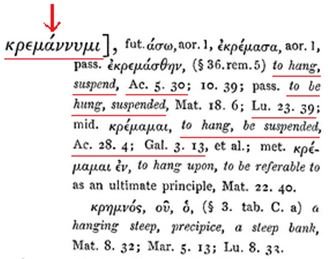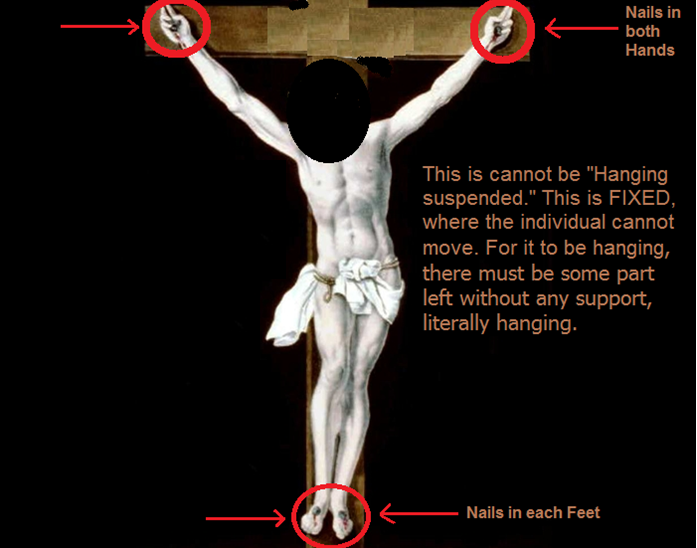𝐖𝐚𝐬 𝐉𝐞𝐬𝐮𝐬 𝐇𝐚𝐧𝐠𝐞𝐝 𝐨𝐫 𝐂𝐫𝐮𝐜𝐢𝐟𝐢𝐞𝐝?
Mohamad Mostafa Nassar
Twitter:@NassarMohamadMR
𝐈𝐧 𝐭𝐡𝐞 𝐟𝐨𝐮𝐫 𝐆𝐨𝐬𝐩𝐞𝐥𝐬 𝐯𝐞𝐫𝐬𝐢𝐨𝐧 𝐨𝐟 𝐭𝐡𝐞 𝐜𝐫𝐮𝐜𝐢𝐟𝐢𝐱𝐢𝐨𝐧 𝐢.𝐞., 𝐌𝐚𝐭𝐭𝐡𝐞𝐰, 𝐌𝐚𝐫𝐤 𝐋𝐮𝐤𝐞 𝐚𝐧𝐝 𝐉𝐨𝐡𝐧, 𝐚𝐥𝐥 𝐟𝐨𝐮𝐫 𝐨𝐟 𝐭𝐡𝐞𝐦 𝐬𝐚𝐲 𝐭𝐡𝐚𝐭 𝐉𝐞𝐬𝐮𝐬 𝐰𝐚𝐬 𝐧𝐚𝐢𝐥𝐞𝐝 𝐭𝐨 𝐚 𝐜𝐫𝐨𝐬𝐬. 𝐁𝐮𝐭 𝐰𝐡𝐞𝐧 𝐰𝐞 𝐫𝐞𝐚𝐝 𝐭𝐡𝐞 𝐀𝐜𝐭𝐬 𝐨𝐟 𝐭𝐡𝐞 𝐀𝐩𝐨𝐬𝐭𝐥𝐞𝐬 𝐢𝐭 𝐬𝐨𝐦𝐞𝐡𝐨𝐰 𝐬𝐚𝐲𝐬 𝐬𝐨𝐦𝐞𝐭𝐡𝐢𝐧𝐠 𝐜𝐨𝐦𝐩𝐥𝐞𝐭𝐞𝐥𝐲 𝐝𝐢𝐟𝐟𝐞𝐫𝐞𝐧𝐭. 𝐀𝐜𝐜𝐨𝐫𝐝𝐢𝐧𝐠 𝐭𝐨 𝐏𝐞𝐭𝐞𝐫’𝐬 𝐬𝐚𝐲𝐢𝐧𝐠 𝐫𝐞𝐜𝐨𝐫𝐝𝐞𝐝 𝐛𝐲 𝐋𝐮𝐤𝐞 𝐢𝐧 𝐀𝐜𝐭𝐬, 𝐉𝐞𝐬𝐮𝐬 𝐰𝐚𝐬 “𝐡𝐚𝐧𝐠𝐞𝐝.”
𝐎𝐧 𝐨𝐧𝐞 𝐡𝐚𝐧𝐝 𝐰𝐞 𝐡𝐚𝐯𝐞 𝐋𝐮𝐤𝐞 𝐫𝐞𝐜𝐨𝐫𝐝𝐢𝐧𝐠 𝐏𝐞𝐭𝐞𝐫 𝐬𝐩𝐞𝐞𝐜𝐡 𝐭𝐡𝐚𝐭 𝐉𝐞𝐬𝐮𝐬 𝐰𝐚𝐬 “𝐡𝐚𝐧𝐠𝐞𝐝” 𝐨𝐧 𝐭𝐡𝐞 𝐨𝐭𝐡𝐞𝐫 𝐡𝐚𝐧𝐝 𝐢𝐧 𝐭𝐡𝐞 ‘𝐆𝐨𝐬𝐩𝐞𝐥 𝐨𝐟 𝐋𝐮𝐤𝐞’ 𝐡𝐞 𝐡𝐢𝐦𝐬𝐞𝐥𝐟 𝐬𝐚𝐲𝐬: 𝐉𝐞𝐬𝐮𝐬 𝐰𝐚𝐬 “𝐜𝐫𝐮𝐜𝐢𝐟𝐢𝐞𝐝” 𝐰𝐢𝐭𝐡 𝐧𝐚𝐢𝐥𝐬 𝐠𝐨𝐢𝐧𝐠 𝐭𝐡𝐫𝐨𝐮𝐠𝐡. 𝐃𝐨 𝐭𝐡𝐞 𝐰𝐨𝐫𝐝𝐬 “𝐇𝐚𝐧𝐠𝐞𝐝” 𝐚𝐧𝐝 “𝐂𝐫𝐮𝐜𝐢𝐟𝐢𝐞𝐝” 𝐡𝐚𝐯𝐞 𝐭𝐡𝐞 𝐬𝐚𝐦𝐞 𝐦𝐞𝐚𝐧𝐢𝐧𝐠𝐬 𝐢𝐧 𝐭𝐡𝐞 𝐆𝐫𝐞𝐞𝐤 𝐥𝐚𝐧𝐠𝐮𝐚𝐠𝐞? 𝐖𝐞𝐥𝐥 𝐰𝐞 𝐡𝐚𝐯𝐞 𝐭𝐨 𝐢𝐧𝐯𝐞𝐬𝐭𝐢𝐠𝐚𝐭𝐞 𝐚𝐧𝐝 𝐬𝐞𝐞 𝐢𝐟 “𝐇𝐚𝐧𝐠𝐞𝐝” (𝐬𝐮𝐬𝐩𝐞𝐧𝐝𝐞𝐝) 𝐨𝐫 𝐜𝐫𝐮𝐜𝐢𝐟𝐢𝐞𝐝 𝐡𝐚𝐯𝐞 𝐭𝐡𝐞 𝐬𝐚𝐦𝐞 𝐦𝐞𝐚𝐧𝐢𝐧𝐠𝐬. 𝐓𝐡𝐢𝐬 𝐢𝐬 𝐭𝐡𝐞 𝐯𝐞𝐫𝐬𝐞 𝐰𝐞 𝐰𝐢𝐥𝐥 𝐞𝐱𝐚𝐦𝐢𝐧𝐞:
𝐀𝐜𝐭𝐬 𝟓:𝟑𝟎 𝐓𝐡𝐞 𝐆𝐨𝐝 𝐨𝐟 𝐨𝐮𝐫 𝐟𝐚𝐭𝐡𝐞𝐫𝐬 𝐫𝐚𝐢𝐬𝐞𝐝 𝐮𝐩 𝐉𝐞𝐬𝐮𝐬, 𝐰𝐡𝐨𝐦 𝐲𝐞 𝐬𝐥𝐞𝐰 𝐚𝐧𝐝 𝐡𝐚𝐧𝐠𝐞𝐝 𝐨𝐧 𝐚 𝐭𝐫𝐞𝐞.
𝐀𝐜𝐭𝐬 𝟓:𝟑𝟎 ὁ θεὸς τῶν πατέρων ἡμῶν ἤγειρεν Ἰησοῦν ὃν ὑμεῖς διεχειρίσασθε κρεμάσαντες ἐπὶ ξύλου (𝐓𝐞𝐱𝐭𝐮𝐬 𝐫𝐞𝐜𝐞𝐩𝐭𝐮𝐬).
𝐖𝐞 𝐬𝐞𝐞 𝐟𝐫𝐨𝐦 𝐏𝐞𝐭𝐞𝐫’𝐬 𝐯𝐞𝐫𝐬𝐢𝐨𝐧 𝐭𝐡𝐚𝐭 𝐉𝐞𝐬𝐮𝐬 𝐰𝐚𝐬 𝐡𝐚𝐧𝐠𝐞𝐝. 𝐓𝐡𝐞 𝐆𝐫𝐞𝐞𝐤 𝐰𝐨𝐫𝐝 𝐭𝐡𝐚𝐭 𝐢𝐬 𝐮𝐬𝐞𝐝 𝐟𝐨𝐫 𝐀𝐜𝐭𝐬 𝟓:𝟑𝟎 𝐟𝐨𝐫 “𝐇𝐚𝐧𝐠𝐢𝐧𝐠” 𝐢𝐬 κρεμάννυμι (𝐤𝐫𝐞𝐦𝐚𝐧𝐧𝐲𝐦𝐢). 𝐈𝐧𝐭𝐞𝐫𝐞𝐬𝐭𝐢𝐧𝐠𝐥𝐲, 𝐢𝐧 𝐧𝐨𝐧𝐞 𝐨𝐟 𝐭𝐡𝐞 𝐆𝐨𝐬𝐩𝐞𝐥𝐬 𝐢𝐬 𝐭𝐡𝐞 𝐰𝐨𝐫𝐝 “𝐤𝐫𝐞𝐦𝐚𝐧𝐧𝐲𝐦𝐢” 𝐟𝐨𝐫 𝐉𝐞𝐬𝐮𝐬’𝐬 𝐜𝐫𝐮𝐜𝐢𝐟𝐢𝐱𝐢𝐨𝐧 𝐮𝐬𝐞𝐝. 𝐁𝐞𝐟𝐨𝐫𝐞 𝐠𝐨𝐢𝐧𝐠 𝐟𝐮𝐫𝐭𝐡𝐞𝐫 𝐨𝐧 𝐀𝐜𝐭𝐬 𝟓:𝟑𝟎, 𝐥𝐞𝐭’𝐬 𝐬𝐡𝐨𝐰 𝐭𝐡𝐞 𝐟𝐨𝐮𝐫 𝐆𝐨𝐬𝐩𝐞𝐥𝐬 𝐚𝐜𝐜𝐨𝐮𝐧𝐭𝐬 𝐢.𝐞 𝐰𝐡𝐚𝐭 𝐰𝐨𝐫𝐝𝐬 𝐭𝐡𝐞𝐲 𝐡𝐚𝐯𝐞 𝐮𝐬𝐞𝐝 𝐟𝐨𝐫 𝐭𝐡𝐞 “𝐜𝐫𝐮𝐜𝐢𝐟𝐢𝐱𝐢𝐨𝐧.”
𝐌𝐚𝐭𝐭𝐡𝐞𝐰 𝟐𝟕:𝟑𝟓 σταυρόω 𝐬𝐭𝐚𝐮𝐫𝐨𝐨̄
𝐌𝐚𝐫𝐤 𝟏𝟓:𝟐𝟒 σταυρόω 𝐬𝐭𝐚𝐮𝐫𝐨𝐨̄
𝐋𝐮𝐤𝐞 𝟐𝟑:𝟑𝟑 σταυρόω 𝐬𝐭𝐚𝐮𝐫𝐨𝐨̄
𝐉𝐨𝐡𝐧 𝟏𝟗:𝟏𝟖 σταυρόω 𝐬𝐭𝐚𝐮𝐫𝐨𝐨̄
𝐈𝐧 𝐚𝐥𝐥 𝐚𝐛𝐨𝐯𝐞 𝐟𝐨𝐮𝐫 𝐆𝐨𝐬𝐩𝐞𝐥𝐬 𝐚𝐜𝐜𝐨𝐮𝐧𝐭𝐬 𝐰𝐞 𝐬𝐞𝐞 𝐭𝐡𝐞 𝐆𝐫𝐞𝐞𝐤 𝐰𝐨𝐫𝐝 𝐭𝐡𝐚𝐭 𝐢𝐬 𝐮𝐬𝐞𝐝 𝐢𝐬 “𝐒𝐭𝐚𝐮𝐫𝐨𝐨” 𝐰𝐡𝐢𝐜𝐡 𝐦𝐞𝐚𝐧𝐬 “𝐂𝐫𝐮𝐜𝐢𝐟𝐢𝐞𝐝” 𝐰𝐢𝐭𝐡 𝐧𝐚𝐢𝐥𝐬 𝐭𝐡𝐫𝐨𝐮𝐠𝐡. 𝐁𝐮𝐭 𝐢𝐧 𝐏𝐞𝐭𝐞𝐫’𝐬 𝐚𝐜𝐜𝐨𝐮𝐧𝐭, 𝐭𝐡𝐚𝐭 𝐢𝐬 𝐫𝐞𝐜𝐨𝐫𝐝𝐞𝐝 𝐛𝐲 𝐋𝐮𝐤𝐞 𝐢𝐧 𝐀𝐜𝐭𝐬, 𝐭𝐡𝐞 𝐰𝐨𝐫𝐝 𝐭𝐡𝐚𝐭 𝐢𝐬 𝐮𝐬𝐞𝐝 𝐚𝐬 𝐈 𝐬𝐡𝐨𝐰𝐞𝐝 𝐞𝐚𝐫𝐥𝐢𝐞𝐫 𝐢𝐬 “𝐤𝐫𝐞𝐦𝐚𝐧𝐧𝐲𝐦𝐢” 𝐰𝐡𝐢𝐜𝐡 𝐦𝐞𝐚𝐧𝐬 “𝐡𝐚𝐧𝐠𝐞𝐝.” 𝐎𝐧𝐞 𝐭𝐡𝐢𝐧𝐠 𝐭𝐨 𝐧𝐨𝐭𝐞, 𝐭𝐡𝐞 𝐆𝐫𝐞𝐞𝐤 𝐰𝐨𝐫𝐝 “𝐒𝐭𝐚𝐮𝐫𝐨𝐨,” 𝐢𝐧 𝐧𝐨 𝐋𝐞𝐱𝐢𝐜𝐨𝐧 𝐝𝐨𝐞𝐬 𝐢𝐭 𝐦𝐞𝐚𝐧 “𝐡𝐚𝐧𝐠𝐢𝐧𝐠”. 𝐋𝐞𝐭 𝐮𝐬 𝐭𝐚𝐤𝐞 𝐚 𝐜𝐥𝐨𝐬𝐞𝐫 𝐥𝐨𝐨𝐤 𝐚𝐭 𝐭𝐡𝐞 𝐆𝐫𝐞𝐞𝐤 𝐰𝐨𝐫𝐝 “𝐤𝐫𝐞𝐦𝐚𝐧𝐧𝐲𝐦𝐢” 𝐚𝐧𝐝 𝐬𝐞𝐞 𝐰𝐡𝐚𝐭 𝐡𝐚𝐯𝐞 𝐋𝐞𝐱𝐢𝐜𝐨𝐧𝐬/𝐃𝐢𝐜𝐭𝐢𝐨𝐧𝐚𝐫𝐢𝐞𝐬 𝐡𝐚𝐯𝐞 𝐭𝐨 𝐬𝐚𝐲 𝐚𝐛𝐨𝐮𝐭 𝐢𝐭.
𝐃𝐞𝐟𝐢𝐧𝐢𝐭𝐢𝐨𝐧(𝐬) 𝐨𝐧 𝐭𝐡𝐞 𝐆𝐫𝐞𝐞𝐤 𝐰𝐨𝐫𝐝 ‘𝐤𝐫𝐞𝐦𝐚𝐧𝐧𝐲𝐦𝐢’ – 𝐆𝐫𝐞𝐞𝐤-𝐄𝐧𝐠𝐥𝐢𝐬𝐡 𝐋𝐞𝐱𝐢𝐜𝐨𝐧𝐬
𝟏. 𝐁𝐞𝐫𝐧𝐚𝐫𝐝 𝐀𝐥𝐰𝐲𝐧 𝐓𝐚𝐲𝐥𝐨𝐫 – 𝐀𝐧𝐚𝐥𝐲𝐭𝐢𝐜𝐚𝐥 𝐋𝐞𝐱𝐢𝐜𝐨𝐧 𝐭𝐨 𝐭𝐡𝐞 𝐒𝐞𝐩𝐭𝐮𝐚𝐠𝐢𝐧𝐭
[𝟏]

𝟐. 𝐉𝐚𝐦𝐞𝐬 𝐒𝐭𝐫𝐨𝐧𝐠 – 𝐀 𝐂𝐨𝐧𝐜𝐢𝐬𝐞 𝐃𝐢𝐜𝐭𝐢𝐨𝐧𝐚𝐫𝐲 𝐨𝐟 𝐭𝐡𝐞 𝐰𝐨𝐫𝐝𝐬 𝐢𝐧 𝐭𝐡𝐞 𝐆𝐫𝐞𝐞𝐤 𝐓𝐞𝐬𝐭𝐚𝐦𝐞𝐧𝐭
𝐊𝐫𝐞𝐦𝐚𝐧𝐧𝐮𝐦𝐢 𝐊𝐫𝐞𝐦-𝐚𝐧’-𝐧𝐨𝐨-𝐦𝐞𝐞: 𝐚 𝐩𝐫𝐨𝐥𝐨𝐧𝐠𝐞𝐝 𝐟𝐨𝐫𝐦 𝐨𝐟 𝐚 𝐩𝐫𝐢𝐦𝐚𝐫𝐲 𝐯𝐞𝐫𝐛; 𝐭𝐨 𝐡𝐚𝐧𝐠:–𝐡𝐚𝐧𝐠. [𝟐]
𝟑. 𝐋𝐢𝐝𝐝𝐞𝐥𝐥 𝐚𝐧𝐝 𝐒𝐜𝐨𝐭𝐭’𝐬 – 𝐀𝐧 𝐈𝐧𝐭𝐞𝐫𝐦𝐞𝐝𝐢𝐚𝐭𝐞 𝐆𝐫𝐞𝐞𝐤 𝐄𝐧𝐠𝐥𝐢𝐬𝐡 𝐋𝐞𝐱𝐢𝐜𝐨𝐧[𝟑]

𝟒. 𝐀𝐛𝐛𝐨𝐭𝐭 𝐒𝐦𝐢𝐭𝐡 – 𝐆𝐞𝐨𝐫𝐠𝐞 𝐀 𝐌𝐚𝐧𝐮𝐞𝐥 𝐆𝐫𝐞𝐞𝐤 𝐋𝐞𝐱𝐢𝐜𝐨𝐧 𝐨𝐟 𝐭𝐡𝐞 𝐍𝐞𝐰 𝐓𝐞𝐬𝐭𝐚𝐦𝐞𝐧𝐭[𝟒]

𝟓. 𝐑𝐨𝐛𝐬𝐨𝐧, 𝐄𝐝𝐰𝐚𝐫𝐝, 𝐆𝐫𝐞𝐞𝐤 𝐚𝐧𝐝 𝐄𝐧𝐠𝐥𝐢𝐬𝐡 𝐋𝐞𝐱𝐢𝐜𝐨𝐧 𝐨𝐟 𝐭𝐡𝐞 𝐍𝐞𝐰 𝐓𝐞𝐬𝐭𝐚𝐦𝐞𝐧𝐭[𝟓]


𝟔. 𝐀𝐥𝐞𝐱𝐚𝐧𝐝𝐞𝐫 𝐒𝐨𝐮𝐭𝐞𝐫 – 𝐀 𝐏𝐨𝐜𝐤𝐞𝐭 𝐋𝐞𝐱𝐢𝐜𝐨𝐧 𝐭𝐨 𝐭𝐡𝐞 𝐆𝐫𝐞𝐞𝐤 𝐍𝐞𝐰 𝐓𝐞𝐬𝐭𝐚𝐦𝐞𝐧𝐭
“κρεμάσαντες (𝐩𝐞𝐧𝐝𝐨), 𝐈 𝐡𝐚𝐧𝐠, 𝐈 𝐬𝐮𝐬𝐩𝐞𝐧𝐝; 𝐦𝐢𝐝. (𝐩𝐞𝐧𝐝𝐞𝐨) 𝐈 𝐚𝐦 𝐡𝐚𝐧𝐠𝐢𝐧𝐠, 𝐈 𝐡𝐚𝐧𝐠” [𝟔]
𝟕. 𝐒𝐚𝐦𝐮𝐞𝐥 𝐁𝐚𝐠𝐬𝐭𝐞𝐫’𝐬. 𝐓𝐡𝐞 𝐀𝐧𝐚𝐥𝐲𝐭𝐢𝐜𝐚𝐥 𝐆𝐫𝐞𝐞𝐤 𝐋𝐞𝐱𝐢𝐜𝐨𝐧: 𝐂𝐨𝐧𝐬𝐢𝐬𝐭𝐢𝐧𝐠 𝐨𝐟 𝐀𝐧 𝐀𝐥𝐩𝐡𝐚𝐛𝐞𝐭𝐢𝐜𝐚𝐥 𝐀𝐫𝐫𝐚𝐧𝐠𝐞𝐦𝐞𝐧𝐭 𝐨𝐟 𝐞𝐯𝐞𝐫𝐲 𝐨𝐜𝐜𝐮𝐫𝐫𝐢𝐧𝐠 𝐈𝐧𝐟𝐥𝐞𝐱𝐢𝐨𝐧 𝐨𝐟 𝐞𝐯𝐞𝐫𝐲 𝐰𝐨𝐫𝐝 𝐜𝐨𝐧𝐭𝐚𝐢𝐧𝐞𝐝 𝐢𝐧 𝐭𝐡𝐞 𝐍𝐞𝐰 𝐓𝐞𝐬𝐭𝐚𝐦𝐞𝐧𝐭 𝐒𝐜𝐫𝐢𝐩𝐭𝐮𝐫𝐞𝐬[𝟕]
𝟖. 𝐉𝐨𝐡𝐧 𝐏𝐢𝐜𝐤𝐞𝐫𝐢𝐧𝐠 – 𝐀 𝐆𝐫𝐞𝐞𝐤 𝐚𝐧𝐝 𝐄𝐧𝐠𝐥𝐢𝐬𝐡 𝐋𝐞𝐱𝐢𝐜𝐨𝐧[𝟖]

𝟗. 𝐒𝐜𝐡𝐫𝐞𝐯𝐞𝐥 𝐂𝐨𝐫𝐧𝐞𝐥𝐢𝐬 – 𝐓𝐡𝐞 𝐆𝐫𝐞𝐞𝐤 𝐋𝐞𝐱𝐢𝐜𝐨𝐧 𝐨𝐟 𝐒𝐜𝐡𝐫𝐞𝐯𝐞𝐥𝐢𝐮𝐬[𝟗]

𝟏𝟎. 𝐂𝐡𝐚𝐫𝐥𝐞𝐬 𝐑𝐨𝐛𝐬𝐨𝐧 – 𝐀 𝐆𝐫𝐞𝐞𝐤 𝐋𝐞𝐱𝐢𝐜𝐨𝐧 𝐭𝐨 𝐭𝐡𝐞 𝐍𝐞𝐰 𝐓𝐞𝐬𝐭𝐚𝐦𝐞𝐧𝐭
προσπήγνυμι 𝐟. 𝐀𝐨𝐫. 𝟏 𝐩𝐚𝐬𝐬., 𝐭𝐨 𝐡𝐚𝐧𝐠, 𝐬𝐮𝐬𝐩𝐞𝐧𝐝 𝐭𝐫𝐚𝐧𝐬,; 𝐦𝐢𝐝… (𝐚𝐟𝐭𝐞𝐫 𝐭𝐡𝐞 𝐟𝐨𝐫𝐦 ), 𝐭𝐨 𝐡𝐚𝐧𝐠 𝐬𝐮𝐬𝐩𝐞𝐧𝐝𝐞𝐝, 𝐢𝐧𝐭𝐫𝐚𝐧𝐬 𝐚) 𝐚𝐜𝐭,. 𝐖𝐢𝐭𝐡 𝐚𝐜𝐜. 𝐈𝐦𝐩𝐥., 𝐚𝐧𝐝 𝐟𝐨𝐥𝐥 𝐛𝐲 𝐰𝐢𝐭𝐡 𝐠𝐞𝐧. 𝐀𝐜𝐭𝐬 𝟓:𝟑𝟎 προσπήγνυμι… : 𝐩𝐚𝐬𝐬., 𝐟𝐨𝐥𝐥 𝐛𝐲 𝐞𝐢𝐬 𝐌𝐚𝐭𝐭 𝟏𝟖:𝟔 𝐚𝐛𝐬𝐨𝐥. 𝐋𝐮𝐤𝐞 𝟐𝟑.𝟑𝟗. 𝐛) 𝐦𝐢𝐝 𝐀𝐜𝐭𝐬 𝟐𝟖:𝟒 [𝟏𝟎]
𝟏𝟏. 𝐉𝐨𝐡𝐧 𝐉𝐨𝐧𝐞𝐬 – 𝐓𝐡𝐞 𝐓𝐲𝐫𝐨’𝐬 𝐆𝐫𝐞𝐞𝐤 𝐚𝐧𝐝 𝐄𝐧𝐠𝐥𝐢𝐬𝐡 𝐋𝐞𝐱𝐢𝐜𝐨𝐧
𝐊𝐏𝐄𝐌𝐀, 𝐟… 𝐈 𝐜𝐚𝐮𝐬𝐞 𝐭𝐨 𝐡𝐚𝐧𝐠, 𝐬𝐮𝐬𝐩𝐞𝐧𝐝 𝐢𝐢.. 𝟏𝟗. 𝐀𝐜𝐭𝐬 𝟓:𝟑𝟎 𝐟… 𝐚𝐨𝐫. 𝐈 𝐬𝐮𝐬𝐩𝐞𝐧𝐝 𝐦𝐲𝐬𝐞𝐥𝐟, 𝐚𝐦 𝐬𝐮𝐬𝐩𝐞𝐧𝐝𝐞𝐝, 𝐈 𝐡𝐚𝐧𝐠, 𝐀𝐜𝐭𝐬 𝟐𝟖:𝟒.— 𝐝𝐞𝐩𝐞𝐧𝐝 ,𝐌𝐚𝐭. 𝟐𝟐. 𝟒. 𝐓𝐡𝐨𝐮 𝐡𝐚𝐬𝐭 𝐬𝐮𝐬𝐩𝐞𝐧𝐝𝐞𝐝, 𝐝𝐢𝐝𝐬𝐭 𝐡𝐚𝐧𝐠 𝐢𝐢… 𝐈 𝐡𝐚𝐧𝐠 𝐨𝐯𝐞𝐫 𝐚 𝐩𝐫𝐞𝐜𝐢𝐩𝐢𝐜𝐞, 𝐬𝐮𝐬𝐩𝐞𝐧𝐝… [𝟏𝟏]
𝟏𝟐. 𝐒𝐚𝐦𝐮𝐞𝐥 𝐂. 𝐋𝐨𝐯𝐞𝐥𝐚𝐧𝐝 – 𝐀 𝐆𝐫𝐞𝐞𝐤 𝐋𝐞𝐱𝐢𝐜𝐨𝐧: 𝐀𝐝𝐚𝐩𝐭𝐞𝐝 𝐭𝐨 𝐭𝐡𝐞 𝐍𝐞𝐰 𝐓𝐞𝐬𝐭𝐚𝐦𝐞𝐧𝐭
κρεμάσαντες 𝐭𝐨 𝐡𝐚𝐧𝐠, 𝐭𝐨 𝐬𝐮𝐬𝐩𝐞𝐧𝐝; 𝐭𝐨 𝐛𝐞 𝐜𝐨𝐧𝐭𝐚𝐢𝐧𝐞𝐝. [𝟏𝟐]
𝐉𝐨𝐡𝐧 𝐉. 𝐎𝐰𝐞𝐧 – 𝐓𝐡𝐞 𝐀𝐜𝐭𝐬 𝐨𝐟 𝐭𝐡𝐞 𝐀𝐩𝐨𝐬𝐭𝐥𝐞𝐬, 𝐢𝐧 𝐭𝐡𝐞 𝐨𝐫𝐢𝐠𝐢𝐧𝐚𝐥 𝐆𝐫𝐞𝐞𝐤
κρεμάσαντες 𝟏. 𝐀𝐨𝐫. 𝐏𝐚𝐬𝐬. 𝐭𝐨 𝐡𝐚𝐧𝐠, 𝐬𝐮𝐬𝐩𝐞𝐧𝐝; 𝐦𝐢𝐝 𝐭𝐨 𝐡𝐚𝐧𝐠, 𝐭𝐨 𝐛𝐞 𝐬𝐮𝐬𝐩𝐞𝐧𝐝𝐞𝐝. [𝟏𝟑]
𝐖. 𝐉. 𝐇𝐢𝐜𝐤𝐢𝐞 𝐆𝐫𝐞𝐞𝐤-𝐄𝐧𝐠𝐥𝐢𝐬𝐡 𝐋𝐞𝐱𝐢𝐜𝐨𝐧 𝐭𝐨 𝐭𝐡𝐞 𝐍𝐞𝐰 𝐓𝐞𝐬𝐭𝐚𝐦𝐞𝐧𝐭. 𝐀𝐟𝐭𝐞𝐫 𝐓𝐡𝐞 𝐋𝐚𝐭𝐞𝐬𝐭 𝐚𝐧𝐝 𝐁𝐞𝐬𝐭 𝐀𝐮𝐭𝐡𝐨𝐫𝐢𝐭𝐢𝐞𝐬
κρεμάσαντες 𝐭𝐨 𝐡𝐚𝐧𝐠 𝐮𝐩, 𝐭𝐨 𝐬𝐮𝐬𝐩𝐞𝐧𝐝, 𝐌𝐚𝐭𝐭. 𝐗𝐯𝐢𝐢𝐢. 𝟔. 𝐀𝐜𝐭𝐬, 𝐕. 𝟑𝟎 𝐱.𝟑𝟗; 𝐦𝐢𝐝., 𝐭𝐨 𝐡𝐚𝐧𝐠 𝐀𝐜𝐭𝐬, 𝐱𝐱𝐯𝐢𝐢𝐢. 𝟒. 𝐆𝐚𝐥. 𝐈𝐢𝐢. 𝟏𝟑; 𝐰𝐢𝐭𝐡 𝐭𝐨 𝐝𝐞𝐩𝐞𝐧𝐝 𝐮𝐩𝐨𝐧 𝐌𝐚𝐭𝐭. 𝐗𝐱𝐢𝐢, 𝟒𝟎. (“𝐀𝐥𝐥 𝐭𝐡𝐞 𝐋𝐚𝐰 𝐚𝐧𝐝 𝐭𝐡𝐞 𝐏𝐫𝐨𝐩𝐡𝐞𝐭𝐬, 𝐢.𝐞 𝐭𝐡𝐞 𝐭𝐞𝐚𝐜𝐡𝐢𝐧𝐠 𝐨𝐟 𝐭𝐡𝐞 𝐎𝐓 𝐨𝐧 𝐦𝐨𝐫𝐚𝐥𝐢𝐭𝐲, 𝐢𝐬 𝐬𝐮𝐦𝐦𝐨𝐧𝐞𝐝 𝐮𝐩 𝐢𝐧 𝐭𝐡𝐞𝐬𝐞 𝐩𝐫𝐞𝐜𝐞𝐩𝐭𝐬,” 𝐓𝐡𝐚𝐲𝐞𝐫.) [𝟏𝟒]
𝐑𝐞𝐚𝐝𝐢𝐧𝐠 𝐚𝐥𝐥 𝐭𝐡𝐞𝐬𝐞 𝐆𝐫𝐞𝐞𝐤-𝐄𝐧𝐠𝐥𝐢𝐬𝐡 𝐋𝐞𝐱𝐢𝐜𝐨𝐧𝐬 𝐢𝐭 𝐢𝐬 𝐜𝐥𝐞𝐚𝐫 𝐭𝐡𝐚𝐭 𝐀𝐜𝐭𝐬 𝟓:𝟑𝟎 𝐦𝐞𝐚𝐧𝐬 “𝐡𝐚𝐧𝐠𝐢𝐧𝐠 𝐬𝐮𝐬𝐩𝐞𝐧𝐝𝐞𝐝.” 𝐍𝐨𝐭𝐢𝐜𝐞 𝐡𝐨𝐰 𝐚𝐥𝐥 𝐨𝐟 𝐭𝐡𝐞𝐦 𝐚𝐠𝐫𝐞𝐞 𝐭𝐡𝐚𝐭 𝐭𝐡𝐞 𝐆𝐫𝐞𝐞𝐤 𝐰𝐨𝐫𝐝 “𝐤𝐫𝐞𝐦𝐚𝐧𝐧𝐲𝐦𝐢” 𝐦𝐞𝐚𝐧𝐬 “𝐡𝐚𝐧𝐠𝐢𝐧𝐠 𝐬𝐮𝐬𝐩𝐞𝐧𝐝𝐞𝐝.” 𝐍𝐨𝐰 𝐢𝐟 𝐉𝐞𝐬𝐮𝐬 𝐰𝐚𝐬 𝐡𝐚𝐧𝐠𝐞𝐝 𝐬𝐮𝐬𝐩𝐞𝐧𝐝𝐞𝐝 𝐚𝐧𝐝 𝐭𝐡𝐞 𝐆𝐨𝐬𝐩𝐞𝐥𝐬 𝐬𝐚𝐲 𝐡𝐞 𝐰𝐚𝐬 𝐜𝐫𝐮𝐜𝐢𝐟𝐢𝐞𝐝 𝐰𝐢𝐭𝐡 𝐧𝐚𝐢𝐥𝐬 𝐠𝐨𝐢𝐧𝐠 𝐭𝐡𝐫𝐨𝐮𝐠𝐡, 𝐢𝐬𝐧’𝐭 𝐭𝐡𝐢𝐬 𝐚 𝐦𝐚𝐣𝐨𝐫 𝐜𝐨𝐧𝐭𝐫𝐚𝐝𝐢𝐜𝐭𝐢𝐨𝐧? 𝐈𝐧 𝐨𝐧𝐞 𝐩𝐥𝐚𝐜𝐞 𝐢𝐭 𝐬𝐚𝐲𝐬 𝐡𝐞 𝐰𝐚𝐬 “𝐡𝐚𝐧𝐠𝐞𝐝 𝐬𝐮𝐬𝐩𝐞𝐧𝐝𝐞𝐝” 𝐛𝐮𝐭 𝐨𝐧 𝐭𝐡𝐞 𝐨𝐭𝐡𝐞𝐫 𝐡𝐚𝐧𝐝 𝐭𝐡𝐞 𝐆𝐨𝐬𝐩𝐞𝐥𝐬 𝐬𝐚𝐲 𝐡𝐞 𝐰𝐚𝐬 “𝐜𝐫𝐮𝐜𝐢𝐟𝐢𝐞𝐝?” 𝐋𝐞𝐭’𝐬 𝐧𝐨𝐰 𝐬𝐡𝐨𝐰 𝐚 𝐜𝐫𝐮𝐜𝐢𝐟𝐢𝐞𝐝 𝐩𝐨𝐫𝐭𝐫𝐚𝐲𝐚𝐥 𝐨𝐟 𝐉𝐞𝐬𝐮𝐬 𝐝𝐞𝐩𝐢𝐜𝐭𝐞𝐝 𝐛𝐲 𝐂𝐡𝐫𝐢𝐬𝐭𝐢𝐚𝐧𝐬 𝐟𝐨𝐫 𝐜𝐞𝐧𝐭𝐮𝐫𝐢𝐞𝐬:

𝐃𝐞𝐩𝐢𝐜𝐭𝐢𝐨𝐧 𝐨𝐟 𝐉𝐞𝐬𝐮𝐬 𝐂𝐫𝐮𝐜𝐢𝐟𝐢𝐱𝐢𝐨𝐧
𝐀𝐬 𝐲𝐨𝐮 𝐬𝐞𝐞 𝐭𝐡𝐞 𝐩𝐢𝐜𝐭𝐮𝐫𝐞 𝐢𝐭 𝐢𝐬 𝐪𝐮𝐢𝐭𝐞 𝐜𝐥𝐞𝐚𝐫 𝐭𝐡𝐚𝐭 𝐀𝐜𝐭𝐬 𝟓:𝟑𝟎 𝐚𝐧𝐝 𝐭𝐡𝐞 𝟒 𝐆𝐨𝐬𝐩𝐞𝐥𝐬 𝐚𝐜𝐜𝐨𝐮𝐧𝐭 𝐨𝐟 𝐭𝐡𝐞 𝐂𝐫𝐮𝐜𝐢𝐟𝐢𝐱𝐢𝐨𝐧 𝐜𝐨𝐧𝐭𝐫𝐚𝐝𝐢𝐜𝐭 𝐞𝐚𝐜𝐡 𝐨𝐭𝐡𝐞𝐫. 𝐀𝐬 𝐈 𝐡𝐚𝐯𝐞 𝐝𝐞𝐦𝐨𝐧𝐬𝐭𝐫𝐚𝐭𝐞𝐝, 𝐭𝐡𝐞 𝐰𝐚𝐲 𝐉𝐞𝐬𝐮𝐬 𝐰𝐚𝐬 𝐜𝐫𝐮𝐜𝐢𝐟𝐢𝐞𝐝 𝐢𝐧 𝐧𝐨 𝐰𝐚𝐲 𝐜𝐨𝐮𝐥𝐝 𝐦𝐞𝐚𝐧 “𝐡𝐚𝐧𝐠𝐢𝐧𝐠 𝐬𝐮𝐬𝐩𝐞𝐧𝐝𝐞𝐝.” 𝐓𝐡𝐞 𝐚𝐛𝐨𝐯𝐞 𝐩𝐢𝐜𝐭𝐮𝐫𝐞 𝐬𝐡𝐨𝐰𝐬 𝐭𝐡𝐚𝐭 𝐭𝐡𝐞 𝐩𝐞𝐫𝐬𝐨𝐧 𝐰𝐡𝐨 𝐢𝐬 𝐧𝐚𝐢𝐥𝐞𝐝 𝐢𝐬 𝐅𝐈𝐗𝐄𝐃. 𝐅𝐨𝐫 𝐢𝐭 𝐭𝐨 𝐛𝐞 𝐇𝐚𝐧𝐠𝐢𝐧𝐠 𝐢𝐭 𝐡𝐚𝐬 𝐭𝐨 𝐡𝐚𝐯𝐞 𝐬𝐨𝐦𝐞 𝐩𝐚𝐫𝐭 𝐥𝐞𝐟𝐭 𝐰𝐢𝐭𝐡𝐨𝐮𝐭 𝐚𝐧𝐲 𝐬𝐮𝐩𝐩𝐨𝐫𝐭.
𝐇𝐨𝐰 𝐝𝐨 𝐰𝐞 𝐤𝐧𝐨𝐰 𝐭𝐡𝐚𝐭 𝐉𝐞𝐬𝐮𝐬 𝐰𝐚𝐬 𝐡𝐚𝐧𝐠𝐞𝐝 𝐚𝐧𝐝 𝐧𝐨𝐭 𝐜𝐫𝐮𝐜𝐢𝐟𝐢𝐞𝐝? 𝐖𝐞𝐥𝐥 𝐀𝐜𝐭𝐬 𝟐:𝟐𝟑 𝐬𝐚𝐲𝐬 𝐢𝐭 𝐚𝐥𝐥, 𝐞𝐯𝐞𝐧 𝐭𝐡𝐨𝐮𝐠𝐡 𝐦𝐚𝐣𝐨𝐫𝐢𝐭𝐲 𝐨𝐟 𝐓𝐫𝐢𝐧𝐢𝐭𝐚𝐫𝐢𝐚𝐧 𝐁𝐢𝐛𝐥𝐞 𝐭𝐫𝐚𝐧𝐬𝐥𝐚𝐭𝐢𝐨𝐧𝐬 𝐡𝐚𝐯𝐞 𝐭𝐫𝐚𝐧𝐬𝐥𝐚𝐭𝐞𝐝 𝐭𝐡𝐞 𝐆𝐫𝐞𝐞𝐤 𝐰𝐨𝐫𝐝 “προσπήγνυμι” (𝐩𝐫𝐨𝐬𝐩𝐞̄𝐠𝐧𝐲𝐦) 𝐚𝐬 “𝐜𝐫𝐮𝐜𝐢𝐟𝐢𝐞𝐝” 𝐭𝐡𝐚𝐭 𝐢𝐬 𝐦𝐢𝐬𝐥𝐞𝐚𝐝𝐢𝐧𝐠. 𝐈𝐟 𝐏𝐞𝐭𝐞𝐫 𝐰𝐚𝐧𝐭𝐞𝐝 𝐭𝐨 𝐬𝐚𝐲 𝐭𝐡𝐚𝐭 𝐉𝐞𝐬𝐮𝐬 𝐰𝐚𝐬 “𝐂𝐫𝐮𝐜𝐢𝐟𝐢𝐞𝐝” 𝐡𝐞 𝐰𝐨𝐮𝐥𝐝𝐧’𝐭 𝐡𝐚𝐯𝐞 𝐮𝐬𝐞𝐝 𝐭𝐡𝐞 𝐰𝐨𝐫𝐝 “𝐩𝐫𝐨𝐬𝐩𝐞̄𝐠𝐧𝐲𝐦”,
𝐢𝐧𝐬𝐭𝐞𝐚𝐝 𝐡𝐞 𝐰𝐨𝐮𝐥𝐝 𝐡𝐚𝐯𝐞 𝐮𝐬𝐞𝐝 “𝐬𝐭𝐚𝐮𝐫𝐨𝐨” 𝐰𝐡𝐢𝐜𝐡 𝐢𝐬 𝐭𝐡𝐞 𝐦𝐨𝐬𝐭 𝐟𝐫𝐞𝐪𝐮𝐞𝐧𝐭 𝐰𝐨𝐫𝐝 𝐮𝐬𝐞𝐝 𝐢𝐧 𝐭𝐡𝐞 𝐍𝐓 𝐟𝐨𝐫 𝐬𝐨𝐦𝐞𝐨𝐧𝐞 𝐰𝐡𝐨 𝐢𝐬 “𝐜𝐫𝐮𝐜𝐢𝐟𝐢𝐞𝐝.” 𝐓𝐡𝐞 𝐆𝐫𝐞𝐞𝐤 𝐰𝐨𝐫𝐝 “𝐩𝐫𝐨𝐬𝐩𝐞̄𝐠𝐧𝐲𝐦” 𝐭𝐡𝐞 𝐦𝐞𝐚𝐧𝐢𝐧𝐠 𝐨𝐟 𝐢𝐭 𝐚𝐜𝐜𝐨𝐫𝐝𝐢𝐧𝐠 𝐭𝐨 𝐒𝐜𝐡𝐨𝐥𝐚𝐫𝐬 𝐨𝐟 𝐆𝐫𝐞𝐞𝐤 𝐥𝐚𝐧𝐠𝐮𝐚𝐠𝐞, 𝐢𝐬 𝐬𝐨𝐦𝐞𝐨𝐧𝐞 𝐰𝐡𝐨 𝐢𝐬 ‘𝐡𝐚𝐧𝐠𝐢𝐧𝐠 𝐬𝐮𝐬𝐩𝐞𝐧𝐝𝐞𝐝’ 𝐰𝐢𝐭𝐡𝐨𝐮𝐭 “𝐧𝐚𝐢𝐥𝐬.” 𝐏𝐚𝐮𝐥 𝐍. 𝐀𝐧𝐝𝐞𝐫𝐬𝐨𝐧, 𝐅𝐞𝐥𝐢𝐱 𝐉𝐮𝐬𝐭 𝐚𝐧𝐝 𝐓𝐨𝐦 𝐓𝐡𝐚𝐭𝐜𝐡𝐞𝐫 𝐜𝐨𝐦𝐦𝐞𝐧𝐭 𝐨𝐧 𝐀𝐜𝐭𝐬 𝟐:𝟐𝟑,
“𝐓𝐡𝐞 𝐚𝐬𝐬𝐮𝐦𝐩𝐭𝐢𝐨𝐧 𝐭𝐡𝐚𝐭 𝐧𝐚𝐢𝐥𝐢𝐧𝐠 𝐰𝐚𝐬 𝐭𝐡𝐞 𝐩𝐫𝐢𝐦𝐚𝐫𝐲 𝐦𝐞𝐭𝐡𝐨𝐝 𝐨𝐟 𝐜𝐫𝐮𝐜𝐢𝐟𝐢𝐱𝐢𝐨𝐧 𝐡𝐚𝐬 𝐮𝐧𝐝𝐮𝐥𝐲 𝐢𝐧𝐟𝐥𝐮𝐞𝐧𝐜𝐞𝐝 𝐭𝐡𝐞 𝐭𝐫𝐚𝐧𝐬𝐥𝐚𝐭𝐢𝐨𝐧 𝐨𝐟 𝐬𝐞𝐯𝐞𝐫𝐚𝐥 𝐩𝐚𝐬𝐬𝐚𝐠𝐞𝐬. 𝐏𝐞𝐭𝐞𝐫’𝐬 𝐬𝐩𝐞𝐞𝐜𝐡 𝐚𝐟𝐭𝐞𝐫 𝐏𝐞𝐧𝐭𝐞𝐜𝐨𝐬𝐭 𝐫𝐞𝐟𝐞𝐫𝐞𝐧𝐜𝐞𝐬 𝐉𝐞𝐬𝐮𝐬 𝐜𝐫𝐮𝐜𝐢𝐟𝐢𝐱𝐢𝐨𝐧: “𝐓𝐡𝐢𝐬 𝐦𝐚𝐧 [𝐉𝐞𝐬𝐮𝐬], 𝐝𝐞𝐥𝐢𝐯𝐞𝐫𝐞𝐝 𝐨𝐯𝐞𝐫 𝐛𝐲 𝐭𝐡𝐞 𝐩𝐫𝐞𝐝𝐞𝐭𝐞𝐫𝐦𝐢𝐧𝐞𝐝 𝐩𝐥𝐚𝐧 𝐚𝐧𝐝 𝐟𝐨𝐫𝐞𝐤𝐧𝐨𝐰𝐥𝐞𝐝𝐠𝐞 𝐨𝐟 𝐆𝐨, 𝐲𝐨𝐮 𝐟𝐚𝐬𝐭𝐞𝐧𝐞𝐝 [προσπήγνυμι] 𝐭𝐨 𝐚 𝐜𝐫𝐨𝐬𝐬” (𝐀𝐜𝐭𝐬 𝟐:𝟐𝟑, 𝐞𝐦𝐩𝐡𝐚𝐬𝐢𝐬 𝐚𝐝𝐝𝐞𝐝).
𝐓𝐡𝐢𝐬 𝐢𝐬 𝐭𝐡𝐞 𝐨𝐧𝐥𝐲 𝐭𝐢𝐦𝐞 𝐭𝐡𝐞 𝐯𝐞𝐫𝐛 προσπήγνυμι (“𝐭𝐨 𝐟𝐚𝐬𝐭𝐞𝐧” 𝐨𝐫 “𝐚𝐟𝐟𝐢𝐱”; 𝐁𝐃𝐀𝐆, 𝟕𝟐𝟓) 𝐢𝐬 𝐮𝐬𝐞𝐝 𝐢𝐧 𝐭𝐡𝐞 𝐍𝐞𝐰 𝐓𝐞𝐬𝐭𝐚𝐦𝐞𝐧𝐭, 𝐚𝐧𝐝 𝐢𝐭 𝐢𝐬 𝐚𝐧 𝐮𝐧𝐮𝐬𝐮𝐚𝐥 𝐭𝐞𝐫𝐦𝐢𝐧𝐨𝐥𝐨𝐠𝐲. 𝐈𝐭 𝐬𝐡𝐨𝐮𝐥𝐝 𝐛𝐞 𝐭𝐫𝐚𝐧𝐬𝐥𝐚𝐭𝐞𝐝 “𝐭𝐨 𝐚𝐟𝐟𝐢𝐱” 𝐨𝐫 “𝐭𝐨 𝐟𝐚𝐬𝐭𝐞𝐧 𝐭𝐨” (𝐅𝐢𝐭𝐳𝐦𝐲𝐞𝐫 𝟏𝟗𝟗𝟖,𝟐𝟓𝟓), 𝐛𝐮𝐭 𝐰𝐢𝐭𝐡𝐨𝐮𝐭 𝐭𝐡𝐞 𝐢𝐦𝐩𝐥𝐢𝐜𝐚𝐭𝐢𝐨𝐧 𝐨𝐟 𝐧𝐚𝐢𝐥𝐬. 𝐘𝐞𝐭 𝐬𝐞𝐯𝐞𝐫𝐚𝐥 𝐄𝐧𝐠𝐥𝐢𝐬𝐡 𝐭𝐫𝐚𝐧𝐬𝐥𝐚𝐭𝐢𝐨𝐧𝐬 𝐬𝐭𝐢𝐥𝐥 𝐫𝐞𝐧𝐝𝐞𝐫 𝐭𝐡𝐢𝐬 𝐯𝐞𝐫𝐛 “𝐭𝐨 𝐧𝐚𝐢𝐥” (𝐬𝐞𝐞 𝐓𝐍𝐈𝐕, 𝐍𝐈𝐕, 𝐍𝐀𝐒𝐁, 𝐍𝐄𝐓, 𝐍𝐂𝐕).” [𝟏𝟓]
𝐍𝐨𝐭𝐢𝐜𝐞 𝐡𝐨𝐰 𝐍. 𝐀𝐧𝐝𝐞𝐫𝐬𝐨𝐧, 𝐅𝐞𝐥𝐢𝐱 𝐉𝐮𝐬𝐭 𝐚𝐧𝐝 𝐓𝐨𝐦 𝐓𝐡𝐚𝐭𝐜𝐡𝐞𝐫 𝐦𝐚𝐤𝐞 𝐢𝐭 𝐜𝐥𝐞𝐚𝐫 𝐭𝐡𝐚𝐭 𝐀𝐜𝐭𝐬 𝟐:𝟐𝟑 𝐦𝐞𝐚𝐧𝐬 𝐡𝐚𝐧𝐠𝐢𝐧𝐠 “𝐰𝐢𝐭𝐡𝐨𝐮𝐭 𝐭𝐡𝐞 𝐢𝐦𝐩𝐥𝐢𝐜𝐚𝐭𝐢𝐨𝐧 𝐨𝐟 𝐧𝐚𝐢𝐥𝐬.” 𝐒𝐢𝐧𝐜𝐞 𝐭𝐡𝐚𝐭 𝐢𝐬 𝐭𝐡𝐞 𝐜𝐚𝐬𝐞, 𝐡𝐨𝐰 𝐜𝐚𝐧 𝐰𝐞 𝐭𝐚𝐤𝐞 𝐭𝐡𝐞 𝐚𝐜𝐜𝐨𝐮𝐧𝐭𝐬 𝐨𝐟 𝐭𝐡𝐞 𝐁𝐢𝐛𝐥𝐞 𝐚𝐬 𝐞𝐯𝐢𝐝𝐞𝐧𝐜𝐞 𝐨𝐟 𝐉𝐞𝐬𝐮𝐬 𝐥𝐢𝐟𝐞 𝐰𝐡𝐞𝐧 𝐭𝐡𝐞 𝐬𝐚𝐦𝐞 𝐩𝐞𝐨𝐩𝐥𝐞 𝐰𝐡𝐨 𝐬𝐨𝐦𝐞𝐡𝐨𝐰 𝐰𝐞𝐫𝐞 𝐝𝐢𝐬𝐜𝐢𝐩𝐥𝐞𝐬 𝐚𝐜𝐜𝐨𝐫𝐝𝐢𝐧𝐠 𝐭𝐨 𝐂𝐡𝐫𝐢𝐬𝐭𝐢𝐚𝐧𝐬 𝐜𝐚𝐧’𝐭 𝐚𝐠𝐫𝐞𝐞 𝐡𝐨𝐰 𝐉𝐞𝐬𝐮𝐬 𝐝𝐢𝐞𝐝?
𝐀𝐜𝐜𝐨𝐫𝐝𝐢𝐧𝐠 𝐭𝐨 𝐀𝐜𝐭𝐬 𝟓:𝟑𝟎, 𝐟𝐫𝐨𝐦 𝐬𝐚𝐲𝐬 𝐭𝐡𝐚𝐭 𝐉𝐞𝐬𝐮𝐬 𝐝𝐢𝐞𝐝 𝐰𝐡𝐢𝐥𝐞 ‘𝐇𝐚𝐧𝐠𝐢𝐧𝐠’ (𝐬𝐮𝐬𝐩𝐞𝐧𝐝𝐞𝐝) 𝐰𝐢𝐭𝐡𝐨𝐮𝐭 𝐚𝐧𝐲 𝐧𝐚𝐢𝐥𝐬. 𝐖𝐡𝐢𝐥𝐞 𝐨𝐧 𝐭𝐡𝐞 𝐨𝐭𝐡𝐞𝐫 𝐡𝐚𝐧𝐝 𝐰𝐞 𝐡𝐚𝐯𝐞 𝐌𝐚𝐭𝐭𝐡𝐞𝐰, 𝐌𝐚𝐫𝐤, 𝐋𝐮𝐤𝐞 𝐚𝐧𝐝 𝐉𝐨𝐡𝐧 𝐰𝐡𝐨 𝐬𝐚𝐲 𝐭𝐡𝐚𝐭 𝐉𝐞𝐬𝐮𝐬 𝐠𝐨𝐭 “𝐜𝐫𝐮𝐜𝐢𝐟𝐢𝐞𝐝” 𝐰𝐢𝐭𝐡 ‘𝐧𝐚𝐢𝐥𝐬’ 𝐠𝐨𝐢𝐧𝐠 𝐭𝐡𝐫𝐨𝐮𝐠𝐡. 𝐖𝐡𝐢𝐜𝐡 𝐚𝐜𝐜𝐨𝐮𝐧𝐭 𝐨𝐟 𝐉𝐞𝐬𝐮𝐬 𝐜𝐫𝐮𝐜𝐢𝐟𝐢𝐱𝐢𝐨𝐧 𝐢𝐬 𝐭𝐫𝐮𝐞?
𝐖𝐞 𝐜𝐨𝐧𝐜𝐥𝐮𝐝𝐞 𝐭𝐡𝐚𝐭 𝐭𝐡𝐞 𝐁𝐢𝐛𝐥𝐞 𝐜𝐚𝐧𝐧𝐨𝐭 𝐛𝐞 𝐚 𝐫𝐞𝐥𝐢𝐚𝐛𝐥𝐞 𝐬𝐨𝐮𝐫𝐜𝐞 𝐨𝐟 𝐉𝐞𝐬𝐮𝐬 𝐥𝐢𝐟𝐞. 𝐖𝐚𝐬 𝐉𝐞𝐬𝐮𝐬 𝐤𝐢𝐥𝐥𝐞𝐝 “𝐡𝐚𝐧𝐠𝐢𝐧𝐠 𝐬𝐮𝐬𝐩𝐞𝐧𝐝𝐞𝐝” 𝐨𝐫 𝐰𝐢𝐭𝐡 𝐧𝐚𝐢𝐥𝐬 𝐟𝐢𝐱𝐞𝐝 𝐭𝐨 𝐭𝐡𝐞 𝐜𝐫𝐨𝐬𝐬? 𝐅𝐮𝐫𝐭𝐡𝐞𝐫𝐦𝐨𝐫𝐞, 𝐰𝐞 𝐜𝐚𝐧 𝐬𝐞𝐞 𝐭𝐡𝐚𝐭 𝐭𝐡𝐞 𝐩𝐞𝐨𝐩𝐥𝐞 𝐰𝐡𝐨 𝐬𝐨𝐦𝐞𝐡𝐨𝐰 𝐤𝐧𝐞𝐰 𝐉𝐞𝐬𝐮𝐬 𝐢𝐧 𝐫𝐞𝐚𝐥 𝐥𝐢𝐟𝐞 𝐜𝐚𝐧’𝐭 𝐚𝐠𝐫𝐞𝐞 𝐨𝐧 𝐡𝐨𝐰 𝐉𝐞𝐬𝐮𝐬 𝐝𝐢𝐞𝐝. 𝐂𝐫𝐮𝐜𝐢𝐟𝐢𝐱𝐢𝐨𝐧 𝐰𝐡𝐢𝐜𝐡 𝐢𝐬 𝐭𝐡𝐞 𝐦𝐚𝐣𝐨𝐫 𝐏𝐢𝐧𝐧𝐚𝐜𝐥𝐞 𝐨𝐟 𝐂𝐡𝐫𝐢𝐬𝐭𝐢𝐚𝐧𝐢𝐭𝐲, 𝐲𝐞𝐭 𝐭𝐡𝐞 𝐩𝐞𝐨𝐩𝐥𝐞 𝐰𝐡𝐨 𝐤𝐧𝐞𝐰 𝐉𝐞𝐬𝐮𝐬, 𝐰𝐚𝐥𝐤𝐞𝐝 𝐰𝐢𝐭𝐡 𝐡𝐢𝐦, 𝐞𝐚𝐭 𝐰𝐢𝐭𝐡 𝐡𝐢𝐦 (𝐚𝐜𝐜𝐨𝐫𝐝𝐢𝐧𝐠 𝐭𝐨 𝐂𝐡𝐫𝐢𝐬𝐭𝐢𝐚𝐧𝐬) 𝐜𝐚𝐧’𝐭 𝐚𝐠𝐫𝐞𝐞 𝐡𝐨𝐰 𝐉𝐞𝐬𝐮𝐬 𝐝𝐢𝐞𝐝?
𝐈𝐟 𝐭𝐡𝐞𝐫𝐞 𝐢𝐬 𝐧𝐨 𝐜𝐫𝐮𝐜𝐢𝐟𝐢𝐱𝐢𝐨𝐧, 𝐭𝐡𝐞𝐫𝐞 𝐢𝐬 𝐧𝐨 𝐂𝐡𝐫𝐢𝐬𝐭𝐢𝐚𝐧𝐢𝐭𝐲. 𝐇𝐨𝐰 𝐜𝐚𝐧 𝐰𝐞 𝐭𝐚𝐤𝐞 𝐭𝐡𝐞 𝐁𝐢𝐛𝐥𝐞 𝐚𝐬 𝐚 𝐬𝐨𝐮𝐫𝐜𝐞 𝐨𝐟 𝐠𝐮𝐢𝐝𝐚𝐧𝐜𝐞 𝐚𝐧𝐝 𝐬𝐚𝐥𝐯𝐚𝐭𝐢𝐨𝐧 𝐰𝐡𝐞𝐧 𝐭𝐡𝐞𝐫𝐞 𝐚𝐫𝐞 𝐦𝐚𝐣𝐨𝐫 𝐜𝐨𝐧𝐭𝐫𝐚𝐝𝐢𝐜𝐭𝐢𝐨𝐧𝐬?
𝐀𝐥𝐥𝐚𝐡 𝐊𝐧𝐨𝐰𝐬 𝐁𝐞𝐬𝐭.
𝐑𝐞𝐟𝐞𝐫𝐞𝐧𝐜𝐞𝐬:
Paul the False of Apostle of Satan
Did 1st Century Christians Reject The Crucifixion?
𝐄𝐱𝐚𝐦𝐢𝐧𝐢𝐧𝐠 𝐏𝐚𝐠𝐚𝐧 𝐒𝐨𝐮𝐫𝐜𝐞𝐬 𝐎𝐧 𝐉𝐞𝐬𝐮𝐬 𝐂𝐫𝐮𝐜𝐢𝐟𝐢𝐱𝐢𝐨𝐧, 𝐆𝐞𝐧𝐮𝐢𝐧𝐞 𝐨𝐫 𝐇𝐞𝐚𝐫𝐬𝐚𝐲?
𝐄𝐱𝐚𝐦𝐢𝐧𝐢𝐧𝐠 𝐉𝐞𝐰𝐢𝐬𝐡 𝐒𝐨𝐮𝐫𝐜𝐞𝐬 𝐎𝐧 𝐉𝐞𝐬𝐮𝐬 𝐂𝐫𝐮𝐜𝐢𝐟𝐢𝐱𝐢𝐨𝐧, 𝐆𝐞𝐧𝐮𝐢𝐧𝐞 𝐎𝐫 𝐅𝐨𝐫𝐠𝐞𝐫𝐲?
𝐄𝐱𝐚𝐦𝐢𝐧𝐢𝐧𝐠 𝐭𝐡𝐞 𝐄𝐧𝐠𝐢𝐧𝐞𝐞𝐫𝐢𝐧𝐠 𝐛𝐞𝐡𝐢𝐧𝐝 𝐉𝐞𝐬𝐮𝐬’ (𝐩) 𝐭𝐢𝐭𝐥𝐞 𝐚𝐬 ‘𝐋𝐚𝐦𝐛 𝐨𝐟 𝐆𝐨𝐝
𝐃𝐢𝐝 𝐞𝐚𝐫𝐥𝐢𝐞𝐬𝐭 𝐂𝐡𝐫𝐢𝐬𝐭𝐢𝐚𝐧𝐬 𝐛𝐞𝐥𝐢𝐞𝐯𝐞 (𝐚𝐥𝐥𝐞𝐠𝐞𝐝) 𝐜𝐫𝐮𝐜𝐢𝐟𝐢𝐱𝐢𝐨𝐧 𝐭𝐨 𝐛𝐞 𝐢𝐧𝐝𝐢𝐬𝐩𝐞𝐧𝐬𝐚𝐛𝐥𝐞?
𝐑𝐞𝐟𝐞𝐫𝐞𝐧𝐜𝐞𝐬:
[𝟏] 𝐁𝐞𝐫𝐧𝐚𝐫𝐝 𝐀𝐥𝐰𝐲𝐧 𝐓𝐚𝐲𝐥𝐨𝐫 𝐀𝐧𝐚𝐥𝐲𝐭𝐢𝐜𝐚𝐥 𝐋𝐞𝐱𝐢𝐜𝐨𝐧 𝐭𝐨 𝐭𝐡𝐞 𝐒𝐞𝐩𝐭𝐮𝐚𝐠𝐢𝐧𝐭 𝐩𝐚𝐠𝐞 𝟑𝟒𝟎
[𝟐] 𝐉𝐚𝐦𝐞𝐬 𝐬𝐭𝐫𝐨𝐧𝐠. 𝐀 𝐂𝐨𝐧𝐜𝐢𝐬𝐞 𝐃𝐢𝐜𝐭𝐢𝐨𝐧𝐚𝐫𝐲 𝐨𝐟 𝐭𝐡𝐞 𝐰𝐨𝐫𝐝𝐬 𝐢𝐧 𝐭𝐡𝐞 𝐆𝐫𝐞𝐞𝐤 𝐓𝐞𝐬𝐭𝐚𝐦𝐞𝐧𝐭
[𝟑] 𝐋𝐢𝐝𝐝𝐞𝐥𝐥 𝐚𝐧𝐝 𝐒𝐜𝐨𝐭’𝐬. 𝐀𝐧 𝐈𝐧𝐭𝐞𝐫𝐦𝐞𝐝𝐢𝐚𝐭𝐞 𝐆𝐫𝐞𝐞𝐤 𝐄𝐧𝐠𝐥𝐢𝐬𝐡 𝐋𝐞𝐱𝐢𝐜𝐨𝐧 𝟏𝟖𝟖𝟐 𝐩𝐚𝐠𝐞 𝟒𝟒𝟗
[𝟒] 𝐀𝐛𝐛𝐨𝐭𝐭 𝐒𝐦𝐢𝐭𝐡, 𝐆𝐞𝐨𝐫𝐠𝐞 𝐀 𝐌𝐚𝐧𝐮𝐞𝐥 𝐆𝐫𝐞𝐞𝐤 𝐋𝐞𝐱𝐢𝐜𝐨𝐧 𝐨𝐟 𝐭𝐡𝐞 𝐍𝐞𝐰 𝐓𝐞𝐬𝐭𝐚𝐦𝐞𝐧𝐭 (𝟏𝟗𝟐𝟐) 𝐩𝐚𝐠𝐞. 𝟐𝟓𝟕
[𝟓] 𝐑𝐨𝐛𝐢𝐧𝐬𝐨𝐧, 𝐄𝐝𝐰𝐚𝐫𝐝, 𝐆𝐫𝐞𝐞𝐤 𝐚𝐧𝐝 𝐄𝐧𝐠𝐥𝐢𝐬𝐡 𝐋𝐞𝐱𝐢𝐜𝐨𝐧 𝐨𝐟 𝐭𝐡𝐞 𝐍𝐞𝐰 𝐓𝐞𝐬𝐭𝐚𝐦𝐞𝐧𝐭 (𝟏𝟖𝟑𝟔) 𝐏𝐚𝐠𝐞 𝟒𝟖𝟗
[𝟔] 𝐀𝐥𝐞𝐱𝐚𝐧𝐝𝐞𝐫 𝐒𝐨𝐮𝐭𝐞𝐫. 𝐀 𝐏𝐨𝐜𝐤𝐞𝐭 𝐋𝐞𝐱𝐢𝐜𝐨𝐧 𝐭𝐨 𝐭𝐡𝐞 𝐆𝐫𝐞𝐞𝐤 𝐍𝐞𝐰 𝐭𝐞𝐬𝐭𝐚𝐦𝐞𝐧𝐭 (𝟏𝟗𝟏𝟕) 𝐏𝐚𝐠𝐞 𝟏𝟑𝟗
[𝟖] 𝐒𝐚𝐦𝐮𝐞𝐥 𝐁𝐚𝐠𝐬𝐭𝐞𝐫’𝐬. 𝐓𝐡𝐞 𝐀𝐧𝐚𝐥𝐲𝐭𝐢𝐜𝐚𝐥 𝐆𝐫𝐞𝐞𝐤 𝐋𝐞𝐱𝐢𝐜𝐨𝐧: 𝐂𝐨𝐧𝐬𝐢𝐬𝐭𝐢𝐧𝐠 𝐨𝐟 𝐀𝐧 𝐀𝐥𝐩𝐡𝐚𝐛𝐢𝐭𝐢𝐜𝐚𝐥 𝐀𝐫𝐚𝐧𝐠𝐞𝐦𝐞𝐧𝐭 𝐨𝐟 𝐞𝐯𝐞𝐫𝐲 𝐨𝐜𝐜𝐮𝐫𝐫𝐢𝐧𝐠 𝐈𝐧𝐟𝐥𝐞𝐱𝐢𝐨𝐧 𝐨𝐟 𝐞𝐯𝐞𝐫𝐲 𝐰𝐨𝐫𝐝 𝐜𝐨𝐧𝐭𝐚𝐢𝐧𝐞𝐝 𝐢𝐧 𝐭𝐡𝐞 𝐍𝐞𝐰 𝐭𝐞𝐬𝐭𝐚𝐦𝐞𝐧𝐭 𝐒𝐜𝐫𝐢𝐩𝐭𝐮𝐫𝐞𝐬. 𝐏𝐚𝐠𝐞 𝟐𝟒𝟎
[𝟕] 𝐉𝐨𝐡𝐧 𝐏𝐢𝐜𝐤𝐞𝐫𝐢𝐧𝐠, 𝐀 𝐆𝐫𝐞𝐞𝐤 𝐀𝐍𝐃 𝐄𝐧𝐠𝐥𝐢𝐬𝐡 𝐋𝐞𝐱𝐢𝐜𝐨𝐧 𝐩𝐚𝐠𝐞 𝟓𝟐𝟏
[𝟖] 𝐒𝐜𝐡𝐫𝐞𝐯𝐞𝐥 𝐂𝐨𝐫𝐧𝐞𝐥𝐢𝐬 𝐓𝐡𝐞 𝐆𝐫𝐞𝐞𝐤 𝐋𝐞𝐱𝐢𝐜𝐨𝐧 𝐨𝐟 𝐒𝐜𝐡𝐫𝐞𝐯𝐞𝐥𝐢𝐮𝐬(𝟏𝟖𝟐𝟔) 𝐩𝐚𝐠𝐞 𝟓𝟏𝟎
[𝟗] 𝐂𝐡𝐚𝐫𝐥𝐞𝐬 𝐑𝐨𝐛𝐬𝐨𝐧 𝐀 𝐆𝐫𝐞𝐞𝐤 𝐋𝐞𝐱𝐢𝐜𝐨𝐧 𝐭𝐨 𝐭𝐡𝐞 𝐍𝐞𝐰 𝐓𝐞𝐬𝐭𝐚𝐦𝐞𝐧𝐭 (𝟏𝟖𝟑𝟔) 𝐏𝐚𝐠𝐞 𝟐𝟒𝟗
[𝟏𝟎] 𝐉𝐨𝐡𝐧 𝐉𝐨𝐧𝐞𝐬, 𝐓𝐡𝐞 𝐓𝐲𝐫𝐨’𝐬 𝐆𝐫𝐞𝐞𝐤 𝐚𝐧𝐝 𝐄𝐧𝐠𝐥𝐢𝐬𝐡 𝐋𝐞𝐱𝐢𝐜𝐨𝐧 (𝟏𝟖𝟐𝟓) 𝐩𝐚𝐠𝐞 𝟒𝟐𝟔
[𝟏𝟏] 𝐒𝐚𝐦𝐮𝐞𝐥 𝐂. 𝐋𝐨𝐯𝐞𝐥𝐚𝐧𝐝 𝐀 𝐆𝐫𝐞𝐞𝐤 𝐋𝐞𝐱𝐢𝐜𝐨𝐧:𝐀𝐝𝐚𝐩𝐭𝐞𝐝𝐭𝐨 𝐭𝐡𝐞 𝐍𝐞𝐰 𝐓𝐞𝐬𝐭𝐚𝐦𝐞𝐧𝐭 (𝟏𝟖𝟐𝟖) 𝐏𝐚𝐠𝐞 𝟏𝟖𝟔
[𝟏𝟐] 𝐉𝐨𝐡𝐧 𝐉. 𝐎𝐰𝐞𝐧 𝐓𝐡𝐞 𝐀𝐜𝐭𝐬 𝐨𝐟 𝐭𝐡𝐞 𝐀𝐩𝐨𝐬𝐭𝐥𝐞𝐬, 𝐢𝐧 𝐭𝐡𝐞 𝐨𝐫𝐢𝐠𝐢𝐧𝐚𝐥 𝐆𝐫𝐞𝐞𝐤. 𝐏𝐚𝐠𝐞 𝟐𝟏𝟐
[𝟏𝟑] 𝐖. 𝐉 𝐇𝐢𝐜𝐤𝐢𝐞 𝐆𝐫𝐞𝐞𝐤-𝐄𝐧𝐠𝐥𝐢𝐬𝐡 𝐋𝐞𝐱𝐢𝐜𝐨𝐧 𝐭𝐨 𝐭𝐡𝐞 𝐍𝐞𝐰 𝐭𝐞𝐬𝐭𝐚𝐦𝐞𝐧𝐭. 𝐀𝐟𝐭𝐞𝐫 𝐓𝐡𝐞 𝐋𝐚𝐭𝐞𝐬𝐭 𝐚𝐧𝐝 𝐁𝐞𝐬𝐭 𝐀𝐮𝐭𝐡𝐨𝐫𝐢𝐭𝐢𝐞𝐬 (𝟏𝟗𝟏𝟏) 𝐏𝐚𝐠𝐞 𝟏𝟎𝟖
[𝟏𝟒] 𝐏𝐚𝐮𝐥 𝐍. 𝐀𝐧𝐝𝐞𝐫𝐬𝐨𝐧, 𝐅𝐞𝐥𝐢𝐱 𝐉𝐮𝐬𝐭, 𝐓𝐨𝐦 𝐓𝐡𝐚𝐭𝐜𝐡𝐞𝐫 𝐉𝐨𝐡𝐧, ‘𝐉𝐞𝐬𝐮𝐬, 𝐚𝐧𝐝 𝐇𝐢𝐬𝐭𝐨𝐫𝐲’, 𝐕𝐨𝐥𝐮𝐦𝐞 𝟐, 𝐩𝐚𝐠𝐞 𝟑𝟐𝟖